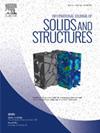A numerical study of the evolution of martensitic crack-tip transformation zones in strain-softening pseudoelastic shape memory alloys
IF 3.4
3区 工程技术
Q1 MECHANICS
International Journal of Solids and Structures
Pub Date : 2025-06-14
DOI:10.1016/j.ijsolstr.2025.113492
引用次数: 0
Abstract
A numerical investigation is performed for strain softening shape memory alloys utilizing a gradient enhanced constitutive model with the finite element method to study the martensitic transformation near the crack tip under mode-I far-field loading. A unique interaction between the length scales, namely the transformation zone size and the material length scale in a softening shape memory alloy, and the morphology of the transformation zone is revealed. Under mode-I loading, the martensitic transformation produces distinct “needles” of intense transformation, and the overall shape of the transformation zone is similar to that in standard plasticity with the size scaling with the square of the far-field applied stress intensity factor divided by the square of the upper plateau transformation stress. Additional simulations reveal that the presence of -stress facilitates the development of these needles and changes their orientation near the crack tip. These simulations indicate that careful observation of the transformation zones near crack tips in SMAs can be used to estimate the characteristic length scale associated with the austenite-to-martensite transition boundary in softening materials.
应变软化伪弹性形状记忆合金马氏体裂纹尖端转变区演化的数值研究
采用梯度增强本构模型和有限元方法,对应变软化形状记忆合金在i型远场载荷作用下裂纹尖端附近的马氏体相变进行了数值研究。揭示了软化形状记忆合金中变形区尺寸和材料长度尺度之间独特的相互作用,以及变形区的形态。在i型加载下,马氏体相变产生明显的强相变“针状体”,相变区整体形状与标准塑性近似,其大小为远场外加应力强度因子的平方除以高原上部变形应力的平方。另外的模拟表明,t应力的存在促进了这些针状结构的发展,并改变了针状结构在裂纹尖端附近的取向。这些模拟表明,仔细观察sma中裂纹尖端附近的转变区可以用来估计与软化材料中奥氏体到马氏体过渡边界相关的特征长度尺度。
本文章由计算机程序翻译,如有差异,请以英文原文为准。
求助全文
约1分钟内获得全文
求助全文
来源期刊
CiteScore
6.70
自引率
8.30%
发文量
405
审稿时长
70 days
期刊介绍:
The International Journal of Solids and Structures has as its objective the publication and dissemination of original research in Mechanics of Solids and Structures as a field of Applied Science and Engineering. It fosters thus the exchange of ideas among workers in different parts of the world and also among workers who emphasize different aspects of the foundations and applications of the field.
Standing as it does at the cross-roads of Materials Science, Life Sciences, Mathematics, Physics and Engineering Design, the Mechanics of Solids and Structures is experiencing considerable growth as a result of recent technological advances. The Journal, by providing an international medium of communication, is encouraging this growth and is encompassing all aspects of the field from the more classical problems of structural analysis to mechanics of solids continually interacting with other media and including fracture, flow, wave propagation, heat transfer, thermal effects in solids, optimum design methods, model analysis, structural topology and numerical techniques. Interest extends to both inorganic and organic solids and structures.

 求助内容:
求助内容: 应助结果提醒方式:
应助结果提醒方式:


